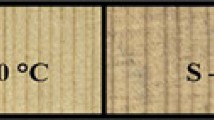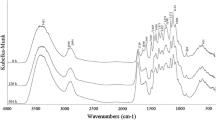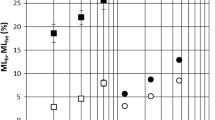Abstract
The formation of chromophore groups from a phenolic compound oxidized with air and the formation of dark materials from hydrolysable extractives are considered as causes of discoloration. In this work, the colour changes, antioxidant capacity, and Fourier Transform Infrared Spectra of dust-wood are investigated in European oak wood under different plain vacuum drying conditions. The conductive heat source is maintained at four temperatures (46, 61, 70 and 80°C), and vacuum in the chamber is controlled at three different intervals (60–100, 150–200, and 250–300 mbar). Drying kinetics and temperature profiles are presented. The results suggest that degradation of extractives allows yellowing in wood and temperature improves lightness under these special drying conditions (plain vacuum). Furthermore, the presence of carbonyl groups in surfaces is related to the loss in antioxidant potency.










Similar content being viewed by others
References
Abe Z, Oda K, Matsumura J (1994) The color change of sugi (Criptomeria japonica) heartwood from reddish brown to black: I the color-change and its causes. Mokuzai Gakkaishi 40(10):1119–1125
Alén R, Kotilainen R, Zaman A (2002) Thermo chemical behaviour of Norway spruce (Picea abies) at 180–225°C. Wood Sci Technol 36:163–171
Alexiadis P, Cohen DH, Kozak RA, Avramidis S (2007) Kiln drying canadian softwoods and hardwoods: different species–different problems. J Inst Wood Sci 17(5):259–267
AO F (1999) Food and Agriculture Organization of the United Nations. Markets for High-Value Tropical Hardwoods in Europe, Forestry Dept
Avramidis S, Ellis S, Liu J (1993) The alleviation of brown stain in hem-fir through manipulation of kiln-drying schedules. For Prod J 43(10):65–69
Banerjee S, Hutten M, Su W, Otwell L, Newton L (1995) Release of water and volatile organics from wood drying. Environ Sci Technol 29(4):1135
Beall FC, Eickner HW (1970) Thermal degradation of wood components: a review of the literature. U.S.D.A, Forest Service Research Paper
Bhuiyan T, Hirai N (2005) Study of crystalline behaviour of heat-treated wood cellulose during treatments in water. J Wood Sci 51:42–47
Bond BH, Kline DE, Araman PA (2002) Differentiating defects in red oak lumber by discriminant analysis using color, shape and density. Wood Fiber Sci 34(4):516–528
Boonstra MJ, Tjeerdsma BF (2006) Chemical analysis of heat treated softwoods. Holz Roh- Werkst 64:204–211
Brunner CC, Shaw GB, Butler DA, Funk JW (1990) Using color in machine vision systems for wood processing. Wood Fiber Sci 22(4):413–428
Burtin P, Jay-Allemand C, Charpentier J, Janin G (2000) Modifications of hybrid walnut (juglans nigra 23 × juglans regia) wood color and phenolic composition under various steaming conditions. Holzforschung 54(1):33–38
Byrne A, Hilbert D (2008) Basic sensible qualities and the structure of appearance. Philosophical Issues 18:385–405 Interdisciplinary Core Philosophy
Charrier B, Haluk JP, Janin G (1992) Prevention of brown discoloration in European oakwood occurring during kiln drying by a vacuum process: colorimetric comparative study with a traditional process. Holz Roh- Werkst 50:433–437
Charrier B, Charrier F, Janin G, Kamdem P, Irmouli M, Goncalez J (2002) Study of industrial boiling process on walnut colour: experimental study under industrial conditions. Holz Roh- Werkst 60:259–264
Conners RW, McMillin CW, Ng CN (1985) The utility of color information in the location and identification of defects in surfaced hardwood lumber. In: Proceedings 1st International Conference on Scanning Technology in Sawmilling, San Francisco, CA
Dawson-Andoh BE, Wiemann M, Matuana L, Baumgras J (2004) Infrared and colorimetric characterization of discolored kiln-dried hard maple lumber. For Prod J 54(1):53–57
Ebermann R, Stich K (1985) Distribution and seasonal variation of wood peroxydase activity in oak (Quercus robur). Wood Fiber Sci 17(3):391–396
Evans P, Chowdhury MJ, Mathews B, Schmalzl K, Ayer S, Kiguchi M, Kataoka Y (2005) weathering and surfae protetion of wood, Chap 14. In: Myer Kutz (ed) Handbook of environmental degradation of materials
Feist WC, Hajny GI, Springer EL (1973) Effect of the storing green wood chips at elevated temperatures. Tappi 56(8):91–95
Fell D (2002) Consumer visual evaluation of canadian wood species. Project No. 3282. Vancouver, British Columbia, Canada: Forintek Canada Corporation. p 111
Fortuin G, Welling J, Hesse C, Brückner G (1988) Verfärbung von Eichenschnittholz bei der Trocknung (1). Holz-Zentralblatt 114:1606–1608
Gao H, Shupe TF, Hse CY, Herberhardt TL (2006) Antioxidant activity of extracts from the bark of Chamaecyparis lawsoniana (A. Murray) Parl. Holzforschung 60:459–462
Gray VR (1961) The color of wood and its changes. J Inst Wood Sci 8:35–57
Grekin M (2007) Colour and colour uniformity variation of Scots pine wood I: the air-dry condition. Wood Fiber Sci 39(2):279–290
Haluk JP, Schoegel F, Metche M (1991) Chimie de la couleur du bois. Etude comparative des constituants polyphénoliques dans le chêne sain et le chêne coloré. Holzforschung 45(6):437–444
Hemingway RW, Hillis WE (1971) Behavior of ellagitannins, galic acid and ellagic acid under alkaline conditions. TAPPI, 54 (6)
Hillis WE (1985) Occurrence of extractives in wood tissues. In: Higuchi T (ed) Biosyntesis and Biodegradation of wood components. Academic Press, London, pp 209–228
Hiltunen E, Tuula TP, Alvila L (2004) Phenolic extractives from wood of birch (Betula pendula). Holzforschung 58:326–329
Hon DN-S (1981) Photochemical degradation of lignocellulosic materials, Chap. 8. In: Grassie N (ed) Developments in polymer degradation. Applied Science Publishers, London
Hon DN-S, Feist C (1986) Weathering characteristics of hardwood surfaces. Wood Sci Technol 20:169–183
Hon DNS, Shiraishi N (eds) (2000) Wood and cellulosic chemistry. Marcel Dekker, New York, p 1020
Kang H-Y (2006) Effect of drying methods on the discoloration of three major domestic softwood species in Korea. For Stud China 8(3):48–50
Jomaa W, Baixeras O (1997) Discontinuous vacuum drying of oak wood: modelling and experimental investigations. Dry Tech 15(9):2129–2144
Kline DE, Surak C, Araman PA (2000) Evaluation of a Multi-Sensor Machine Vision System for Automated Hardwood Lumber Grading In: Proceedings: 4th International Conference on Image Processing and Scanning of Wood. IPSW. 21–23 August, 2000. Mountain Lake Resort, Mountain Lake, Virginia, USA
Klumpers J, Scalbert A, Janin G (1994) Ellagitannins in European oak wood: polymerization during wood ageing. Phytochemistry 36:1249–1252
Koch G (2008) Discoloration of wood in the living tree and during processing. Conference COST E53, 29–30 October 2008, Delft, The Netherlands 11
Koch G, Skarvelis M (2002) Advances in the drying of wood. In: Proceedings of COST Action E15 4rd Workshop on methods for improving drying quality of wood”. 30–31 May 2002, Santiago de Compostela, Spain. Methods for improving drying quality of wood
Koch G, Puls J, Bauch J (2003) Topochemical characterisation of phenolic extractives in discolored beechwood (Fagus sylvatica L.). Holzforschung 57:339–345
Kosiková B, Hricovíni M, Consentino C (1999) Interaction of lignin and polysaccharides in beech wood (Fagus sylvatica) during drying process. Wood Sci Technol 33:373–380
Luostarinen K (2006) Relationship of selected cell characteristics and color of silver birch wood after two different drying processes. Wood Mater Sci Eng 1:21–28
Nuopponen MH, Wikberg HI, Birch GM, Jääskeläinen A, Maunu SL, Vuorinen T (2006) Characterization of 25 tropical hardwoods with fourier transform infrared, ultraviolet resonance raman, and13C-NMR cross-polarization/magic- angle spinning spectroscopy. J Appl Polym Sci 102(1):810–819
Okuda T, Yoshida T, Hatano T (1989) New methods of analyzing tannins. J Nat Prod 52:1–31
Okuyama T, Yamamoto H, Kobayashi I (1990) Quality improvement in small log of sugi by direct heating method II. Wood Ind 45:63–67
Pandey KK, Pitman AJ (2003) FTIR studies of the changes in wood chemistry following decay by brown-rot and white-rot fungi. Int Biodeterior Biodegradation 52:151–160
Perraudeau M (2004) Lumière et couleur. Techniques de l′Ingénieur. Document C 3 340−341
Rowell MR (2006) Chemical modification of wood: a short review. Wood Mater Sci Eng 1:29–33
Silvén S, Kauppinen H (1996) Recent developments in wood inspection. Int Pattern Recognit Artificial Intell 10(1):83–95
Simpson WT (1987) Vacuum drying northern red oak. For Prod J 37(1):35–48
Sivonen H, Nuopponen M, Maunu SL, Sundholm F, Vuorinen T (2003) 13C CP/MAS NMR and FTIR studies of thermally modified wood exposed to brown and soft rot fungi. Appl Spectrosc 57:266–273
Stamm AJ (1956) Thermal degradation of wood and cellulose. Ind Eng Chem 48:413–417
Stenudd S (2004) Color response in Silver birch during kiln-drying. For Prod J 54(6):31–36
Stich K, Ebermann R (1987) Oak peroxydase: relationship with polyphenoloxydase. Holzforschung 41:19–21
Sundqvis B (2002) Color response of scots pine (Pinus sylvestris), Norway spruce (Picea abies) and birch (Betula pubescens) subjected to heat treatment in capillary phase. Holz Roh- Werkst 60:106–114
Thompson DW, Kozak RA, Evans PD (2005) Thermal modification of color in red alder veneer. I. effects of temperature, heating time, and wood type. Wood Fiber Sci 37(4):653–661
Tjeerdsma B, Boonstra M, Pizzi A, Tekely P, Militz H (1998) Characterisation of thermally modified wood: molecular reasons for wood performance improvement. Holz Roh-Werkst 56:149–153
Toivonen R, Hansen E, Järvinen E, Enroth R-R (2005) The competitive position of the Nordic wood industry in Germany–intangible quality dimensions. Silva Fennica 39(2):277–287
Turner IW, Perré P (2004) Vacuum drying of wood with radiative heating: II. comparison between theory and experiment. AIChE J 50:108–118
Wålinder M (2006) Editorial. Wood Mater Sci Eng J 1:2–3
Ward JC, Simpson WT (1997) Drying Defects. In: Simson WT (ed) Dry kiln operator’s manual. Reprinted from U.S.D.A. Agricultural Handbook No. 188. Madison, WI, pp 179–205
White RH, Dietenberger MA (2001) Wood products: thermal degradation and fire. Encyclopedia of Materials: Science and Technology, pp 9712–9716. ISBN: 0-08-0431526
Wikberg H, Maunu SL (2004) Characterisation of thermally modified hard and softwoods by 13C CPMAS NMR. Carbohydr Polym 58:461–466
Yeo H, Smith WB (2004) Control of interior darkening in hard maple. Wood Fiber Sci 36(3):417–422
Zanetti M, Mothe F, Merlin A, Janin G, Le Moguédec G, Goncalez J (2003) Conséquences du vieillissement du bois de chêne sessile sur la perception esthétique par les utilisateurs. Ann For Sci 60:1–8
Acknowledgments
This work was supported by The National Council for Science and Technology of Mexico (CONACYT) and SFERE-France. Sadoth Sandoval-Torres PhD is thankful to Instituto Politécnico Nacional (CIIDIR Oaxaca) for its support.
Author information
Authors and Affiliations
Corresponding author
Rights and permissions
About this article
Cite this article
Sandoval-Torres, S., Jomaa, W., Marc, F. et al. Colour alteration and chemistry changes in oak wood (Quercus pedunculata Ehrh) during plain vacuum drying. Wood Sci Technol 46, 177–191 (2012). https://doi.org/10.1007/s00226-010-0381-z
Received:
Published:
Issue Date:
DOI: https://doi.org/10.1007/s00226-010-0381-z




